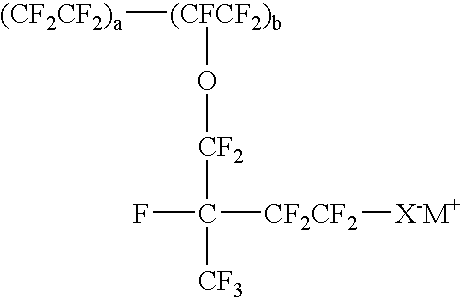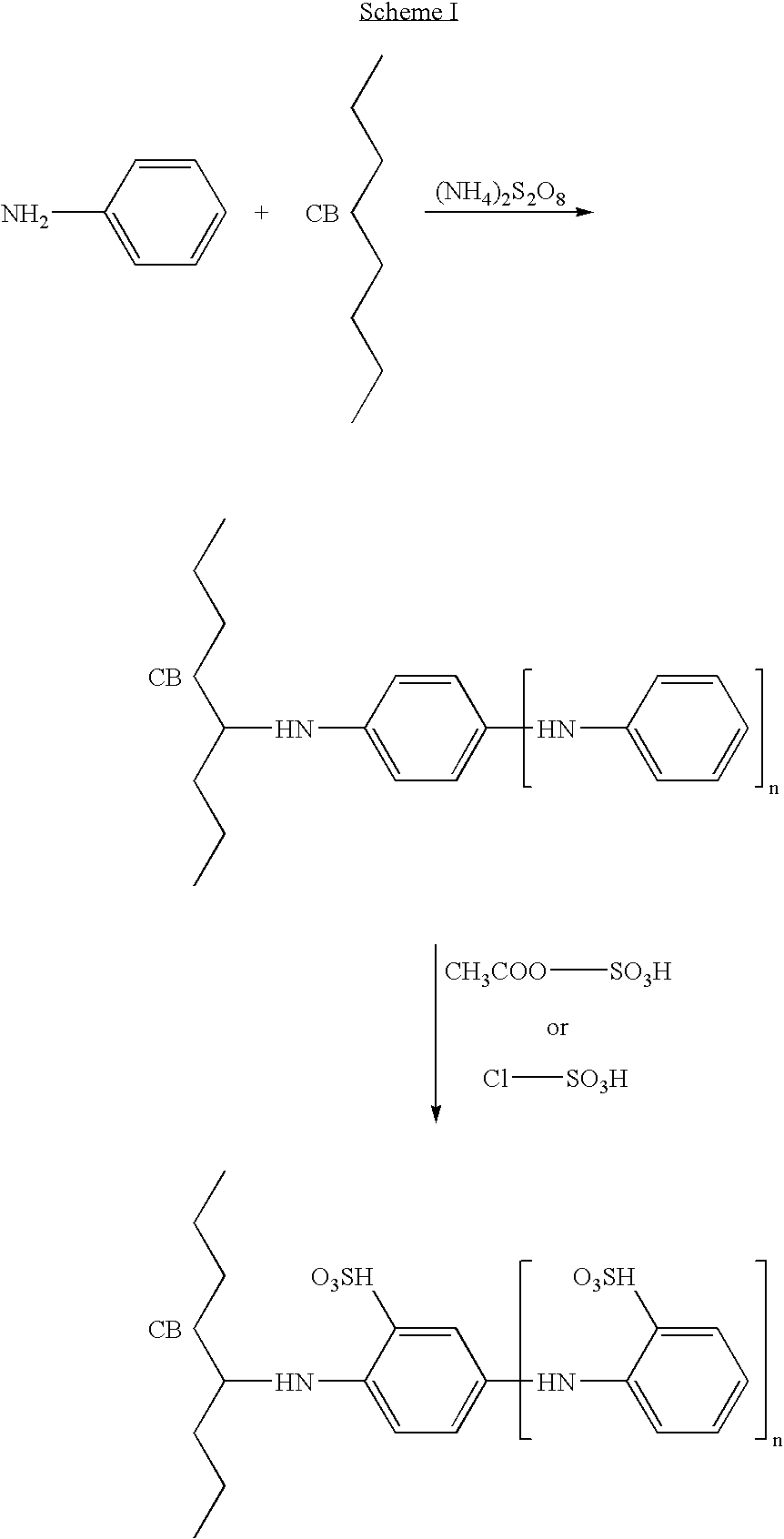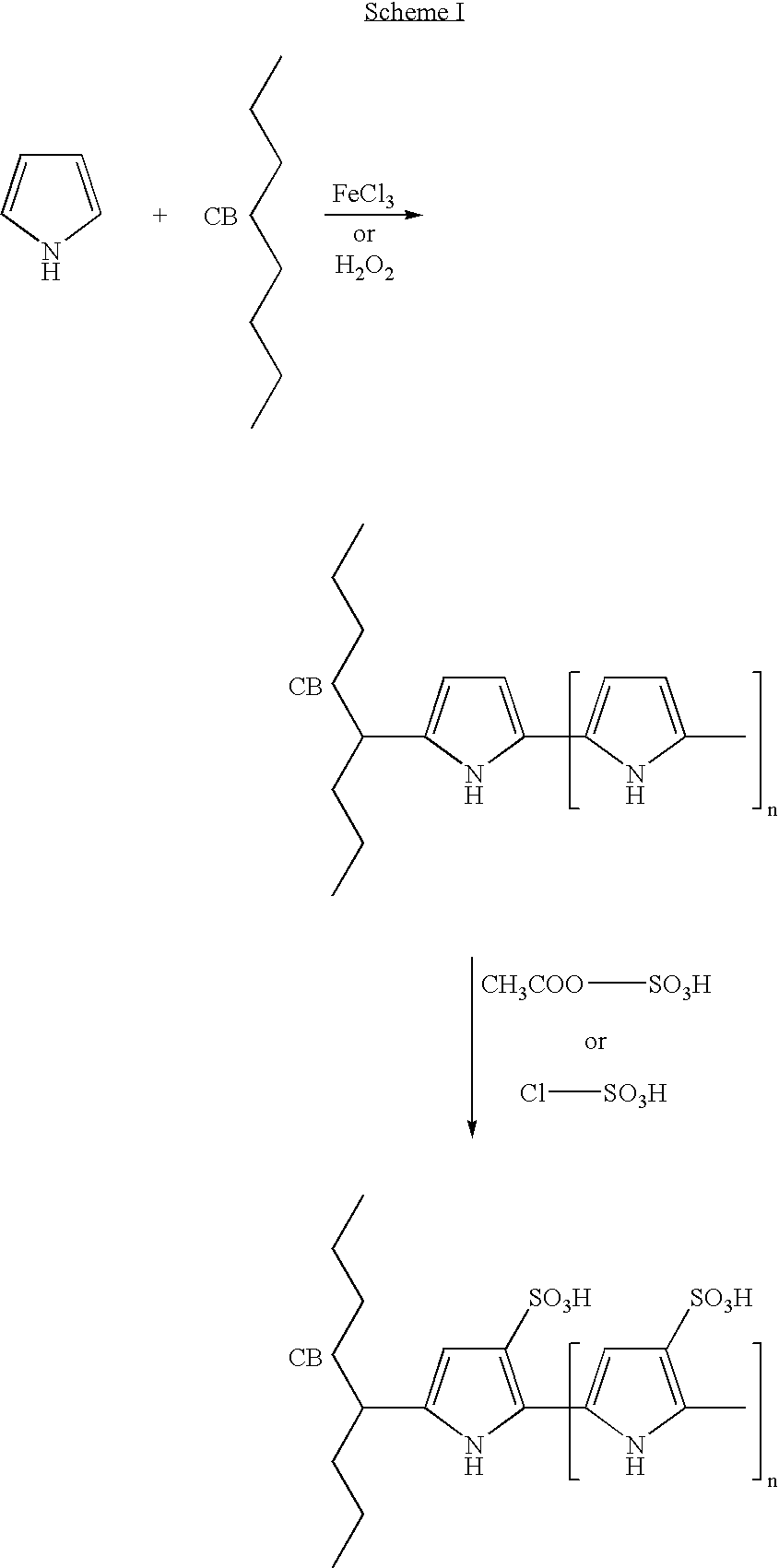Sulfonated conducting polymer-grafted carbon material for fuel cell applications
a technology of sulfonated conducting and polymer-grafted carbon, which is applied in the direction of non-metal conductors, cell components, conductors, etc., can solve the problems of limited kinetic performance of pem fuel cells, reduced efficiency of fuel cells, and limited o.sub.2 reduction half reaction
- Summary
- Abstract
- Description
- Claims
- Application Information
AI Technical Summary
Problems solved by technology
Method used
Image
Examples
example 1
Preparation of Sulfonated Polyaniline-Grafted Carbon Black
[0245] This example describes grafting of polyaniline to carbon black surface by using aniline and ammonium persulfate followed by direct sulfonation.
[0246] A slurry was made using
[0247] 100 g CDX-975 carbon black (NSA surface area 240 m.sup.2 / g and oil absorption of 170 ml / 100 g) (Columbian Chemical Company, Atlanta, Ga.) and
[0248] 25 ml glacial acetic acid in
[0249] 750 ml deionized (DI) water.
2 CDX-975 "typical" properties Property Value Mean particle size (nm) 21 ASTM D3849 NSA surface area (m.sup.2 / g) 242 ASTM D4820 STSA surface area (m.sup.2 / g) 130 ASTM D5816 DBPA oil absorption (cc / 100 g) 169 Beads ASTM D2414 DBPA oil absorption (cc / 100 g) -- Powder ASTM D2414 % volatile 1.0 Blackness index 112 Tint strength 87 ASTM D3265
[0250] 20 g aniline (Aldrich, 98% purity) was added to the slurry with continuous stirring.
[0251] A solution containing 45 g of ammonium persulfate in 250 ml deionized water was added to the carbon blac...
example 2
Preparation of Sulfonated Polypyrrole-Grafted Carbon Black
[0254] This example describes grafting of polypyrrole to carbon black surface by using pyrrole and ferric chloride solution followed by direct sulfonation.
[0255] A slurry was made using
[0256] 100 g CDX-975 carbon black (NSA surface area 240 m.sup.2 / g and oil absorption of 170 ml / 100 g) (Columbian Chemical Company, Atlanta, Ga.) and
[0257] 25 ml glacial acetic acid in
[0258] 750 ml deionized (DI) water.
[0259] 20 g pyrrole (Aldrich) was added to the slurry with continuous stirring.
[0260] 100 ml of 3 M FeCl.sub.3 solution was added to the carbon black slurry, and the stirring continued at room temperature for 1 hr.
[0261] A solution containing 30 ml concentrated H.sub.2SO.sub.4 and 60 ml acetic anhydride was added to the slurry and stirred at room temp for 1 hour.
[0262] The carbon black slurry was filtered, washed with DI water, dried at 110.degree. C. for 4 hrs., and pulverized. The resultant carbon powder contains sulfonated poly...
example 3
Preparation of Sulfonated Polypyrrole-Grafted Carbon Black
[0263] This example describes grafting of polypyrrole to carbon black surface by using pyrrole and hydrogen peroxide solution followed by direct sulfonation.
[0264] A slurry was made using
[0265] 100 g CDX-975 carbon black (NSA surface area 240 m.sup.2 / g and oil absorption of 170 ml / 100 g) (Columbian Chemical Company, Atlanta, Ga.) and
[0266] 25 ml glacial acetic acid in
[0267] 750 ml deionized (DI) water.
[0268] 20 g pyrrole (Aldrich) was added to the slurry with continuous stirring.
[0269] 100 ml of 10% H.sub.2O.sub.2 solution was added to the carbon black slurry, and the stirring continued at room temperature for 1 hr.
[0270] A solution containing 30 ml concentrated H.sub.2SO.sub.4 and 60 ml acetic anhydride was added to the slurry and stirred at room temp for 1 hour.
[0271] The carbon black slurry was filtered, washed with DI water, dried at 110.degree. C. for 4 hrs., and pulverized. The resultant carbon powder contains sulfonate...
PUM
| Property | Measurement | Unit |
|---|---|---|
| Temperature | aaaaa | aaaaa |
| Temperature | aaaaa | aaaaa |
| thickness | aaaaa | aaaaa |
Abstract
Description
Claims
Application Information
 Login to View More
Login to View More - R&D
- Intellectual Property
- Life Sciences
- Materials
- Tech Scout
- Unparalleled Data Quality
- Higher Quality Content
- 60% Fewer Hallucinations
Browse by: Latest US Patents, China's latest patents, Technical Efficacy Thesaurus, Application Domain, Technology Topic, Popular Technical Reports.
© 2025 PatSnap. All rights reserved.Legal|Privacy policy|Modern Slavery Act Transparency Statement|Sitemap|About US| Contact US: help@patsnap.com



